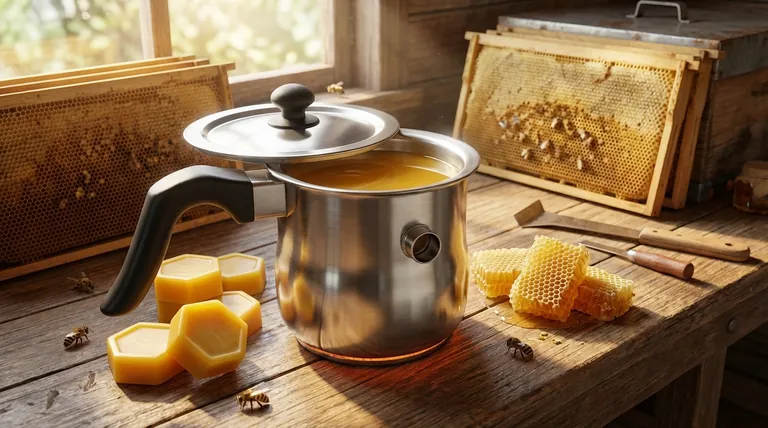In short, beeswax is not gathered but manufactured. It is a biological substance produced by specialized glands on the abdomen of worker honey bees. This liquid secretion hardens into small, clear scales upon contact with the air, which the bees then collect and manipulate with their legs and mouthparts to construct their honeycomb.
The core takeaway is that beeswax production is a metabolically expensive and deliberate act of biological engineering. A honey bee colony must consume significant amounts of honey to fuel the creation of this essential building material, which forms the very foundation of their home and pantry.

The Anatomy of a Wax Factory
The ability to produce wax is a specific role fulfilled by certain bees within the hive. It is a critical function that depends entirely on the anatomy of the worker bee.
The Worker Bee's Glands
Only worker bees produce wax. They do so using four pairs of specialized glands located on the underside of their abdomen. These glands are most productive in young worker bees, typically between 12 and 20 days old.
From Secretion to Scale
The glands secrete a clear, liquid wax. When this liquid is exposed to the air, it hardens almost instantly into small, flat, and somewhat transparent wax scales.
The Step-by-Step Construction Process
Producing the raw material is only the first step. The bees must then process these scales into a functional building material.
Harvesting the Scales
A bee uses the stiff spines on its middle legs to scrape the wax scales from its own abdomen. It then passes these scales forward to its front legs and, ultimately, to its mouthparts, or mandibles.
Manipulation and Placement
Once at the mandibles, the bee chews and manipulates the wax scale. This process mixes the wax with saliva, making it more pliable and soft. The bee then carefully places and shapes this prepared wax to form the iconic six-sided cells of the honeycomb.
The Purpose of the Comb
This meticulously constructed comb serves as the hive's infrastructure. The cells are used to store honey and pollen (bee bread) and to house the queen's eggs and developing larvae, known as brood.
The High Cost of Production
Creating beeswax is not a simple or "free" activity for the colony. It represents a significant investment of resources and energy that directly impacts the hive's survival.
The Energy Investment in Wax
Beeswax production is an incredibly energy-intensive process. The colony must consume a large amount of honey to fuel the wax glands of the worker bees. It is estimated that bees need to consume around fifty pounds of honey to produce just ten pounds of beeswax.
Why the Hexagonal Shape?
The hexagonal cell structure is a marvel of natural engineering. This shape allows bees to store the maximum amount of honey and brood using the least amount of wax, creating an incredibly strong and efficient structure. There is simply no wasted space.
Applying This Understanding
Recognizing the process and cost of wax production provides a deeper appreciation for the honey bee's life cycle and resource management.
- If your primary focus is beekeeping: Understanding that wax production is tied to honey consumption helps you manage feeding schedules and know when to add or remove frames to support hive health.
- If your primary focus is natural products: Knowing that beeswax is a direct, resource-intensive product of the bee itself explains its value and why it is a prized, natural material.
This intricate biological process underscores the honey bee colony's incredible efficiency and its ability to create a perfect home from its own body.
Summary Table:
| Key Aspect | Description |
|---|---|
| Producer | Young worker bees (12-20 days old) |
| Source | Secreted from 4 pairs of abdominal glands |
| Raw Material | Liquid wax that hardens into clear scales |
| Energy Cost | ~50 lbs of honey to produce 10 lbs of wax |
| Final Product | Hexagonal honeycomb cells for storage and brood |
Need Reliable Beekeeping Equipment for Your Productive Hive?
Understanding the immense energy bees invest in wax production highlights the need for durable, efficient hive components. HONESTBEE supplies high-quality beekeeping supplies and equipment to commercial apiaries and distributors through our wholesale-focused operations. Our products are designed to support the natural behaviors of your bees, helping you manage hive health and maximize productivity.
Contact HONESTBEE today to discuss your wholesale needs and learn how our equipment can contribute to the success of your operation.
Visual Guide

Related Products
- Beeswax Melter for Candle Making Honey Bee Wax Melter
- Steam Beeswax Melter Wax Warmer for Wax Processing
- Electric Honey Press Machine for Squeezing Honey Comb Press Equipment
- Professional 500g Sectional Comb Honey Frame System for Beekeeping
- Stainless Steel Honey Press Wax Press with Tank
People Also Ask
- What are the benefits of using a professional wax melter? Achieve Consistent, Scalable, and Safe Production
- What is the flashpoint of beeswax? Essential Safety and Quality Tips for Beekeepers
- What makes polyurethane foam environmentally friendly? The Surprising Benefits of a Durable, Inert Material
- What do you use a wax melter for? From Home Fragrance to Professional Beekeeping
- What are the main types of wax melters? Choose the Right Heating Method for Your Needs



















